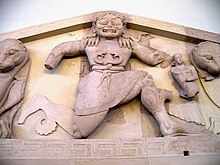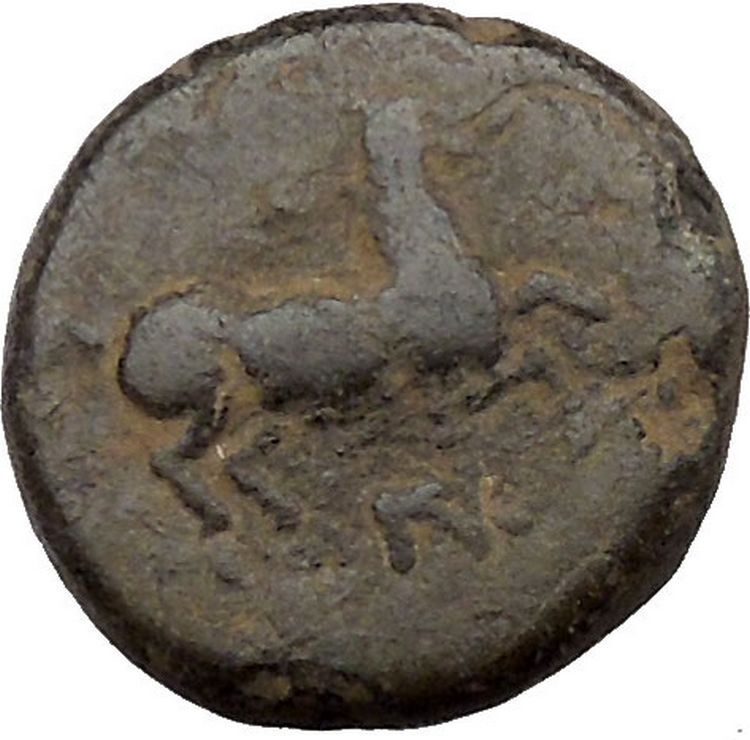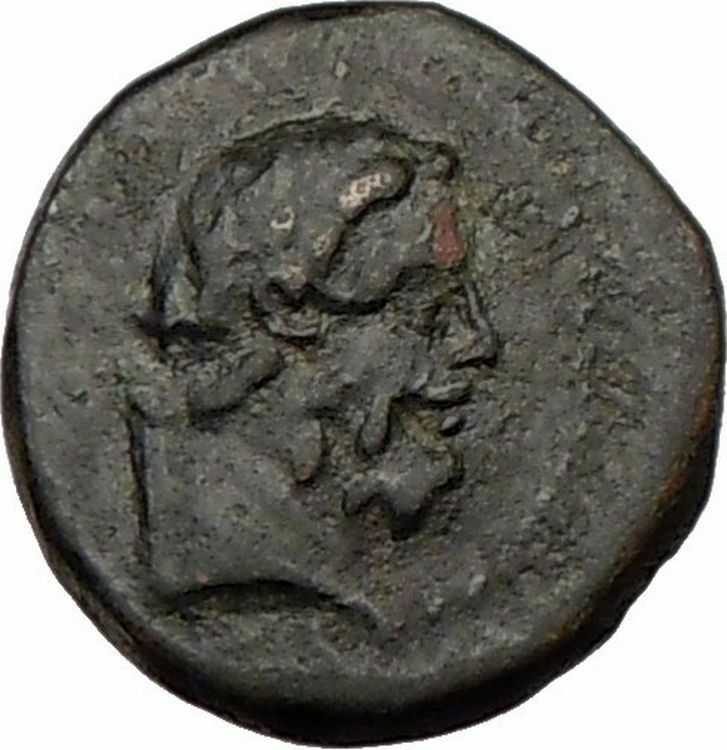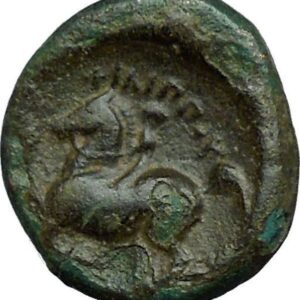|
Greek city of Parion in Mysia
Silver Drachm 14mm (2.94 grams) Struck circa 480 B.C.
Reference: Sear 3917; B.M.C. 15.94,1
Gorgoneion.
Incuse square containing cruciform pattern with pellet at center.
On the shores of the Propontis, Parion was founded circa 710
B.C. and became a flourishing port through the excellence of its harbor.
You are bidding on the exact item pictured,
provided with a Certificate of Authenticity and Lifetime Guarantee of
Authenticity.
The Aegis as stated in the
Iliad
, is the
shield
or
buckler
or breastplate of
Athena
and
Zeus, famously bearing
Medusa
‘s head, which, according to
Homer
was fashioned by
Hephaestus
“… and among them went bright-eyed
Athene, holding the precious aegis which is ageless and immortal: a hundred
tassels of pure gold hang fluttering from it, tight-woven each of them, and each
the worth of a hundred oxen.”

The aegis on the Lemnian Athena of
Phidias
, represented by a cast at
the
Pushkin Museum
The modern concept of doing something “under someone’s aegis” means
doing something under the protection of a powerful, knowledgeable, or benevolent
source. The word aegis is identified with protection by a strong force
with its roots in
Greek mythology
and adopted by the Romans;
there are parallels in
Norse mythology
and in
Egyptian mythology
as well, where the Greek
word aegis is applied by extension.
In Greek mythology
Virgil imagines the
Cyclopes
in Hephaestus’ forge, who “busily
burnished the aegis Athene wears in her angry moods—a fearsome thing with a
surface of gold like scaly snake-skin, and he linked serpents and the
Gorgon
herself upon the goddess’s breast—a
severed head rolling its eyes.” furnished with golden tassels and bearing the
Gorgoneion
(Medusa‘s
head) in the central boss. Some of the
Attic
vase-painters retained an archaic
tradition that the tassels had originally been
serpents
in their representations of the aegis.
When the Olympian deities overtook the older deities of Greece and she was born
of
Metis
(inside
Zeus who had swallowed the goddess) and “re-born” through the head of
Zeus fully clothed, Athena already wore her typical garments.
When the Olympian shakes the aegis,
Mount Ida
is wrapped in clouds, the thunder
rolls and men are struck down with fear. “Aegis-bearing Zeus”, as he is in the
Iliad, sometimes lends the fearsome goatskin to
Athena
. In the Iliad when Zeus sends
Apollo
to revive the wounded
Hector of Troy
, Apollo, holding the aegis,
charges the Achaeans, pushing them back to their ships drawn up on the shore.
According to
Edith Hamilton
‘s Mythology: Timeless Tales
of Gods and Heroes,[3]
the Aegis is the
breastplate
of
Zeus, and was “awful to behold.”
Locating the Aegis

Athena’s aegis, bearing the Gorgon, here resembles closely the skin
of the huge serpent who guards the golden fleece (regurgitating
Jason); cup by Douris, Classical Greece, early fifth century BC—Vatican
Museum
Greeks of the Classical age
always detected
that there was something alien and uncanny about the Aegis. It was supposed by
Euripides
(Ion, 995) that the
Gorgon
was the original possessor of this
goatskin, yet the usual understanding is that the Gorgoneion was added
to the Aegis, a
votive gift
from a grateful
Perseus
.
There also is the origin myth that represents the ægis as a fire-breathing
chthonic
monster similar to the
Chimera
, which was slain and flayed by
Athena
, who afterward wore its skin as a
cuirass
(Diodorus
Siculus iii. 70), or as a
chlamys
. The Douris cup shows that the Aegis
was represented exactly as the skin of the guardian serpent, with its scales
clearly delineated. Often the Aegis is described as the bag in which Athene
carried her shield and the serpent who was her son.
John Tzetzes
says that it was the skin of the
monstrous giant
Pallas
whom Athena overcame and whose name she
attached to her own (name).
In a late rendering by
Hyginus
(Poetical Astronomy ii. 13),
Zeus is said to have used the skin of the
goat deity
Amalthea
(aigis “goat-skin”) which
suckled him in Crete
, as a shield when he went forth to do
battle against the
Titans
. She is thought to bear the name of the
deity who was derived from Libya, where known as
Neith
, the same source sometimes identified as
the parallel for Athene.
In accordance with this double meaning, the Aegis appears in works of art
sometimes as an animal’s skin thrown over the shoulders and arms, and sometimes
as a cuirass, with a border of snakes corresponding to the tassels of Homer,
usually with the Gorgon head, the gorgoneion, in the centre.

First century BC
mosaic
of Alexander the Great
wearing the aegis on a
mosaic from Pompeii
(Naples
National Archaeological Museum)
It often is represented on the statues of
Roman
emperors, heroes, and warriors as well as
on cameos and vases. A vestige of that appears in a portrait of
Alexander the Great
in a fresco from Pompeii
dated to the first century BC, which shows the image of the head of a woman on
his armor that resembles the Gorgon.
Origins
Herodotus
(Histories iv.189) thought he
had identified the source of the ægis in
Libya
, which was always a distant territory of
ancient magic for the Greeks:
- Athene’s garments and ægis were borrowed by the Greeks from the
Libyan women, who are dressed in exactly the same way, except that their
leather garments are fringed with thongs, not serpents.
Robert Graves
in The Greek Myths (1955;
1960) asserts that the ægis in its Libyan sense had been a shamanic pouch
containing various ritual objects, bearing the device of a monstrous
serpent-haired visage with tusk-like teeth and a protruding tongue which was
meant to frighten away the uninitiated. In this context, Graves identifies the
aegis as clearly belonging first to Athena.

Augustus
is shown with an aegis
thrown over his shoulder as a divine attribute in the
Blacas Cameo
; the hole for the head
appears at the point of his shoulder.
Another version[citation
needed] describes it to have been really the goat’s
skin used as a belt to support the shield. When so used it would generally be
fastened on the right shoulder, and would partially envelop the chest as it
passed obliquely round in front and behind to be attached to the shield under
the left arm. Hence, by
metonymy
, it would be employed to denote at
times the shield which it supported, and at other times a
cuirass
, or
chlamys
, the purpose of which it in part
served. In accordance with this double meaning, the ægis appears in works of art
sometimes as an animal’s skin thrown over the shoulders and arms, and sometimes
as a cuirass, with a border of snakes corresponding to the tassels of Homer,
usually with the Gorgon’s head, the gorgoneion, in the centre. It is
often represented on the statues of
Roman
emperors, heroes, and warriors, and on
cameos and vases.
A current modern interpretation is that the
Hittite
sacral hieratic hunting bag (kursas),
a rough and shaggy goatskin that has been firmly established in literary texts
and iconography by H.G. Güterbock, is the most likely source of the aegis.
Etymology
Greek
Αιγίς has three meanings:
- “violent windstorm”, from the verb ‘αïσσω (stem
‘αïγ-) = “I rush or move violently”. Akin to “καταιγίς” hurricane.
- The shield of a deity as described above
- “goatskin coat”, from treating the word as meaning “something
grammatically feminine pertaining to
goat
” (Greek αἰξ (stem
αἰγ-) = “goat”, + suffix -ίς (stem ίδ-))
The original meaning may have been #1, and Ζευς ‘Αιγιοχος = “Zeus who holds
the aegis” may have originally meant “Sky/Heaven, who holds the storm”. The
transition to the meaning “shield” may have come by
folk-etymology
among a people familiar with
draping an animal skin over the left arm as a shield.
In Egyptian
and Nubian tradition

Aegis of Neith
from the
Twenty-sixth dynasty of Egypt
(Museum
of Fine Arts of Lyon)
The aegis also appears in Ancient
Egyptian mythology
. The goddess
Bast
sometimes was depicted holding a
ceremonial sistrum
in one hand and an aegis in the other –
the aegis usually resembling a collar or
gorget
embellished with a
lioness head.
Plato
drew a parallel between Athene and the
ancient Libyan and Egyptian goddess
Neith
, a
war deity
who also was depicted carrying a
shield.

Aegis on an image of
Isis
from 4th-century BC
Nubia
(British
Museum)
Ancient Nubia
shared many aspects of its mythology with
ancient Egypt and there is debate about the original source of some religious
concepts that the two cultures share and, whether the assimilation was from
Nubia to Egypt, the reverse, or through continuing exchanges. At one time the
Kush
of Nubia ruled ancient Egypt.
An image of Isis wearing an aegis was discovered in present-day
Sudan
, the territory of Nubia when the artifact
was made in the 4th century BC. It is likely to be an artifact of the
flourishing culture of
Meroë
, successors to the culture of Kush, as
indicated by the use of
Egyptian hieroglyphs
and
cartouches
.
In Norse mythology
In
Norse mythology
, the dragon
Fafnir
(best known in the form of a dragon
slain by Sigurðr) bears on his forehead the Ægis-helm (ON ægishjálmr), or Ægir’s
helmet, or more specifically the “Helm of Terror”. However, some versions would
say that Alberich was the one holding a helm, named as the Tarnkappe,
which has the power to make the user invisible. It may be an actual helmet or a
magical sign with a rather poetic name. Ægir is an Old Norse word meaning
“terror” and the name of a destructive giant associated with the sea; ægis
is the
genitive
(possessive) form of ægir and
has no direct relation to Greek aigis.
In
Greek mythology
Medusa (Greek:
Μέδουσα (Médousa), “guardian, protectress”)
was a monster
, a
Gorgon
, generally described as having the face
of a hideous human female with living venomous snakes in place of hair. Gazing
directly upon her would turn onlookers to stone. Most sources describe her as
the daughter of Phorcys
and
Ceto, though the author
Hyginus
(Fabulae,
151) interposes a generation and gives Medusa another chthonic pair as parents.
Medusa was beheaded by the hero
Perseus
, who thereafter used her head as a
weapon until he gave it to the goddess
Athena
to place on her
shield
. In
classical antiquity
the image of the head of
Medusa appeared in the
evil-averting device
known as the
Gorgoneion
.
Medusa in
classical mythology

Perseus with the Head of Medusa
,
by
Benvenuto Cellini
, installed 1554
The three Gorgon
sisters—Medusa,
Stheno
, and
Euryale
—were all children of the ancient marine
deities Phorcys
(or Phorkys) and his sister
Ceto (or Keto),
chthonic
monsters from an
archaic
world. Their genealogy is shared with
other sisters, the Graeae
, as in
Aeschylus
‘s
Prometheus Bound
, which places both
trinities of sisters far off “on Kisthene’s dreadful plain”:
Near them their sisters three, the Gorgons, winged
With snakes for hair— hated of mortal man—
While ancient Greek vase-painters and relief carvers imagined Medusa and her
sisters as beings born of monstrous form, sculptors and vase-painters of the
fifth century began to envisage her as being beautiful as well as terrifying. In
an ode written in 490 BC
Pindar
already speaks of “fair-cheeked Medusa”.
In a late version of the Medusa myth, related by the Roman poet
Ovid (Metamorphoses 4.770), Medusa was originally a
ravishingly beautiful maiden, “the jealous aspiration of many suitors,”
priestess in Athena’s temple, but when she was caught being raped by the “Lord
of the Sea” Poseidon
in
Athena
‘s temple, the enraged Athena transformed
Medusa’s beautiful hair to serpents and made her face so terrible to behold that
the mere sight of it would turn onlookers to stone. In Ovid’s telling, Perseus
describes Medusa’s punishment by Minerva (Athena) as just and well earned.
Death
In most versions of the story, she was
beheaded
by the
hero
Perseus
, who was sent to fetch her head by King
Polydectes
of Seriphus. In his conquest, he
received a mirrored shield from
Athena
, gold, winged sandals from
Hermes
, a sword from
Hephaestus
and Hades’ helm of invisibility.
Medusa was the only one of the three Gorgons who was mortal, so Perseus was able
to slay her while looking at the reflection from the mirrored shield he received
from Athena. During that time, Medusa was pregnant by
Poseidon
. When Perseus beheaded her,
Pegasus
, a winged horse, and
Chrysaor
, a golden sword-wielding giant, sprang
from her body.

Head of Medusa, gate of the
Royal Palace of Turin
Jane Ellen Harrison
argues that “her potency
only begins when her head is severed, and that potency resides in the head; she
is in a word a mask with a body later appended… the basis of the
Gorgoneion
is a
cultus object
, a ritual mask misunderstood.”[6]
In the Odyssey
xi,
Homer
does not specifically mention the
Gorgon
Medusa:
Lest for my daring
Persephone
the dread,
From Hades should send up an awful monster’s grisly head.
Harrison’s translation states “the Gorgon was made out of the terror, not the
terror out of the Gorgon.”According to
Ovid, in northwest Africa, Perseus flew past the
Titan
Atlas
, who stood holding the sky aloft, and
transformed him into stone when he tried to attack him. In a similar manner, the
corals
of the
Red Sea
were said to have been formed of
Medusa’s blood spilled onto
seaweed
when Perseus laid down the petrifying
head beside the shore during his short stay in
Ethiopia
where he saved and wed his future
wife, the lovely princess
Andromeda
. Furthermore the poisonous vipers of
the Sahara
, in the
Argonautica
4.1515, Ovid’s
Metamorphoses
4.770 and Lucan’s
Pharsalia
9.820, were said to have grown
from spilt drops of her blood. The blood of Medusa also spawned the
Amphisbaena
(a horned dragon-like creature with
a snake-headed tail).
Perseus then flew to Seriphos, where his mother was about to be forced into
marriage with the king. King Polydectes was turned into stone by the gaze of
Medusa’s head. Then Perseus gave the Gorgon’s head to Athena, who placed it on
her shield, the Aegis
.
Some classical references refer to three Gorgons; Harrison considered that
the tripling of Medusa into a trio of sisters was a secondary feature in the
myth:
The triple form is not primitive, it is merely an instance of a general
tendency… which makes of each woman goddess a trinity, which has given
us the Horae
, the
Charites
, the
Semnai
, and a host of other triple
groups. It is immediately obvious that the Gorgons are not really three
but one + two. The two unslain sisters are mere appendages due to
custom; the real Gorgon is Medusa.
Modern interpretations
Psychoanalysis

An
archaic
Medusa wearing the belt of
the intertwined snakes, a fertility symbol, as depicted on the west
pediment
of the
Artemis Temple in Corfu
, exhibited
at the
Archaeological Museum of Corfu
In 1940,
Sigmund Freud
‘s Das Medusenhaupt (Medusa’s
Head) was published posthumously. This article laid the framework
for his significant contribution to a body of criticism surrounding the monster.
Medusa is presented as “the supreme
talisman
who provides the image of
castration
— associated in the child’s mind
with the discovery of maternal sexuality — and its denial.”
Psychoanalysis
continue
archetypal literary criticism
to the present
day:
Beth Seelig
analyzes Medusa’s punishment from
the aspect of the crime of having been raped rather than having willingly
consented in Athena’s temple as an outcome of the goddess’ unresolved conflicts
with her own father, Zeus
.
Feminism
In the 20th century,
feminists
reassessed Medusa’s appearances in
literature and in modern culture, including the use of Medusa as a
logo by fashion company
Versace
. The name “Medusa” itself is often used
in ways not directly connected to the mythological figure but to suggest the
gorgon’s abilities or to
connote
malevolence; despite her origins as a
beauty, the name in common usage “came to mean monster.” The book Female
Rage: Unlocking Its Secrets, Claiming Its Power by Mary Valentis and Anne
Devane notes that “When we asked women what female rage looks like to them, it
was always Medusa, the snaky-haired monster of myth, who came to mind … In one
interview after another we were told that Medusa is ‘the most horrific woman in
the world’ … [though] none of the women we interviewed could remember the
details of the myth.”[15]

Medusa mosaic (Roman period),
National Archaeological Museum, Athens
Medusa’s visage has since been adopted by many women as a symbol of female
rage; one of the first publications to express this idea was a 1978 issue of
Women: A Journal of Liberation. The cover featured the image of a Gorgon,
which the editors explained “can be a map to guide us through our terrors,
through the depths of our anger into the sources of our power as women.”[15]
In a 1986 article for Women of Power magazine called “Ancient Gorgons: A
Face for Contemporary Women’s Rage,” Emily Erwin Culpepper wrote that “The
Amazon Gorgon face is female fury personified. The Gorgon/Medusa image has been
rapidly adopted by large numbers of feminists who recognize her as one face of
our own rage.”
In Ancient Greece
, the
Gorgoneion (Greek:
Γοργόνειον) was originally a horror-creating
apotropaic
pendant
showing the
Gorgon
‘s head. It was associated with the
deities Zeus
and
Athena
; both are said to have worn it as a
pendant
. It was also popular as a royal
aegis
, as shown, for instance, on the
Alexander Mosaic
and the
Gonzaga Cameo
.
Parium (or Parion)
was a
Greek
city in
Mysia
on the
Hellespont
. It became a Roman Catholic
titular see
,
suffragan
of
Cyzicus
in the
Roman province
of
Hellespontus
.
//
Located near
Lampsacus
, it was a
colony
probably founded by
Eretria
and
Paros
. It belonged to the
Delian League
. In the
Hellenistic period
it came under the domain of
Lysimachus
, and subsequently the
Attalid dynasty
. In
Roman
times, it was a
Colonia
, within the
province
of
Asia
; and after the province was divided in the
4th century AD
, it was in the province of
Hellespontus
. The ancient coinage of Parium is
quite abundant, attesting to its great output and advanced mint (in Hellenistic
times, the city’s badge shown on coins was the
Gorgoneion
).
Christian history
The Acts of the martyr
St. Onesiphorus
prove that there was a
Christian community there before 180. Other saints worthy of mention are:
St. Menignus
, martyred under
Decius
and venerated on 22 November;
St. Theogenes
, bishop and martyr, whose feast
is observed on 3 January;
St. Basil
, bishop and martyr in the ninth
century, venerated on 12 April.
Le Quien
(Oriens christianus I, 787-90)
mentions 14 bishops, the last of whom lived in the middle of the fourteenth
century. An anonymous Latin bishop is mentioned in 1209 by
Innocent III
(Le Quien, op. cit., III, 945) and
a titular bishop in 1410 by
Eubel
(Hierarchia Catholica medii ævi,
I, 410).
At first a suffragan of the
Archbishopric
, Parium became an
autocephalous
archdiocese
as early as 640 (Heinrich
Gelzer, Ungedruckte … Texte, 535) and remained so till the
end of the thirteenth century. Then the Emperor
Andronicus II
made it a
metropolis
under the title of Pegon kai
Pariou.
In 1354
Pegæ
and Parium (the Latin forms of both names)
were suppressed, the incumbent
metropolitan
receiving in exchange the See of
Sozopolis
in
Thrace
(Miklosich and Müller, “Acta
patriarchatus Constantinopolitani”, I, 109, 111, 132, 300, 330). This was the
end of the episcopal see.
The ruins of Parium were under Ottoman rule at the Greek village of
Kamares
(the vaults), on the small cape
Tersana-Bournou in the
caza
and
sandjak
of
Bigha
.
|


















